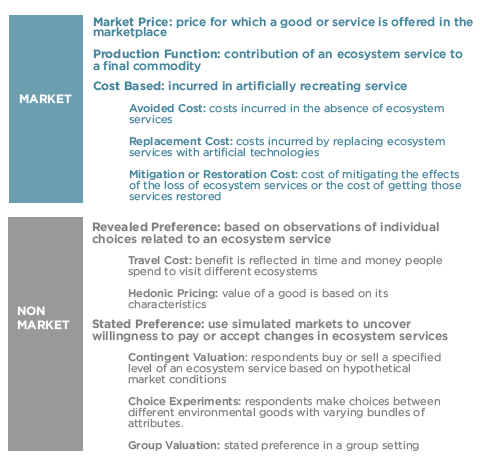By Cheryl Geslani
The Earth’s environment is divided into different combinations of living organisms and their nonliving surroundings: air, water and soil. These different organic communities are called ecosystems. Humans receive benefits from these ecosystems in the form of “ecosystem services”, a term that covers a range of benefits from artistic inspiration to soil detoxification. (See below for a list of example ecosystem services)*
In 1997 Robert Costanza and 12 other authors wrote an eye-opening article in Nature called “The value of the world’s ecosystem services and natural capital” (Costanza et al. 1997). It stoked interest in environmental valuation because of the $46 trillion/year value (in 2007 US dollars) it placed on the planet’s services. After factoring land use change the value of Earth’s services in 2011 was updated to $125 trillion/year (in 2007 US dollars) (Costanza et al. 2014). The goal of Costanza et al. (1997) was not to commodify the environment, but more so to raise awareness to what these environmental benefits are worth in a capitalist market economy. The methods for arriving at these dollar figures were questioned and the valuation was controversial because some people are naturally inclined to ask…
How can you put a dollar value on the environment?
Putting aside the ethical question of assigning dollar values to experiences and connectivity with other people and nature, the below table sums up how previous academic research has addressed environmental valuation:

Prices of goods and services sold in markets can be used to arrive at a dollar value for certain aspects of the environment, but in the case that market values are not available, non-market based methodologies have been used to arrive at a value. Ecosystem service valuation is a relatively new field and researchers are collecting results from previous studies to help future researchers confirm what valuation methods work best for different ecosystem services (Ecosystem Services Valuation Database). A paper was written by De Groot et al. (2002) which includes a table of ecosystem functions and their compatibility with different valuation techniques to help guide in assigning a dollar value to ecosystem services. With some ecosystem services there are intrinsic values (such as existence values) that are hard to put into dollar terms. It doesn’t always have to be about money….
There is more than one way to value the environment
Ecosystem services do not have to be valued in terms of dollars. Any unit can be the common denominator such as time, energy, or freshwater, for example. Environmental valuation differs from financial valuation in that it is rarely done to account for an entity’s profit, it is done to account for alterations humans have made on the environment, or to help decision makers evaluate consequences of their actions. Farber et al. (2002) defines valuation as an assessment of trade-offs toward achieving a goal such as reduced carbon emission, increased habitat or improved water quality.
An important concept to keep in mind is that people do not directly benefit from ecosystems without human, social and built capital. The valuation of the environment’s natural capital must be parsed out from the entire interaction between people, communities and their built environment. It is only through institutions as well as human management and invention that we extract benefit from nature (Costanza et al. 2014). The scope, precision, techniques and units used in an environmental valuation depend on the purpose. Ecosystem service valuations are done at different spatial scales to suit different objectives such as raising awareness, national income and well-being accounts, specific policy analyses, land use planning, payment for ecosystem services, full cost accounting and common asset trusts. For more information on the field of ecosystem service valuation check out references below:
Ecosystem Services:
The Ecosystem Services Partnership
The Economics of Ecosystems & Biodiversity Initiative
*(List comes from the Ecosystem Services Valuation Database)
| Air quality regulation | Fish | Pollination of crops |
| Animal genetic resources | Flood prevention | Prevention of extreme events [unspecified] |
| Artistic inspiration | Fodder | Provisioning values [unspecified] |
| Attractive landscapes | Food [unspecified] | Raw materials [unspecified] |
| Biochemicals | Fuel wood and charcoal | Recreation |
| Biodiversity protection | Gas regulation | Refugia for migratory and resident species |
| Biological control [unspecified] | Genetic resources [unspecified] | Regulating [unspecified] |
| Biomass fuels | Hunting / fishing | River discharge |
| Bioprospecting | Hydro-electricity | Sand, rock, gravel. Coral |
| C-sequestration | Industrial water | Science / research |
| Capturing fine dust | Inspiration [unspecified] | Seed dispersal |
| Climate regulation [unspecified] | Irrigation water [unnatural] | Soil detoxification |
| Cultural use | Maintenance of soil structure | Soil formation |
| Cultural values [unspecified] | Meat | Solar energy |
| Decorations / Handicrafts | Microclimate regulation | Spiritual / Religious use |
| Deposition of nutrients | Natural irrigation | Storm protection |
| Disease control | NTFPs [food only!] | TEV |
| Drainage | Nursery service | Timber |
| Drinking water | Nutrient cycling | Tourism |
| Dyes, oils, cosmetics (Natural raw material for) | Other ESS | Various |
| Ecotourism | Other Raw | Waste treatment [unspecified] |
| Education | Pest control | Water [unspecified] |
| Energy other | Pets and captive animals | Water Other |
| Erosion prevention | Plants / vegetable food | Water purification |
| Fibers | Pollination [unspecified] | Water regulation [unspecified] |
| Fire prevention |
BLOG POSTS ARE PRELIMINARY MATERIALS CIRCULATED TO STIMULATE DISCUSSION AND CRITICAL COMMENT. THE VIEWS EXPRESSED ARE THOSE OF THE INDIVIDUAL AUTHORS. WHILE BLOG POSTS BENEFIT FROM ACTIVE UHERO DISCUSSION, THEY HAVE NOT UNDERGONE FORMAL ACADEMIC PEER REVIEW.